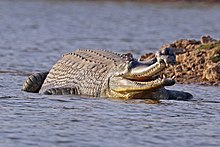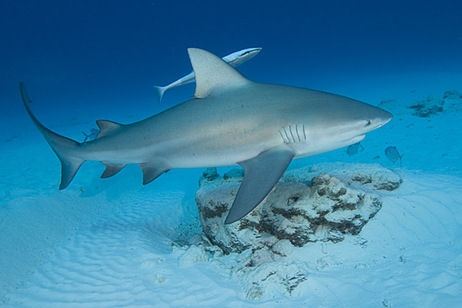Post by dinosauria101 on Aug 16, 2019 16:59:11 GMT 5
Indian Gharial (Gavial) - Gavialis gangeticus
The gharial (Gavialis gangeticus) is a crocodilian of the family Gavialidae that is native to the Indian subcontinent and also called gavial and fish-eating crocodile. The gharial is one of three crocodilians native to India, apart from the mugger crocodile and the saltwater crocodile. It is one of the longest of all living crocodilians. Gharials' well-developed laterally flattened tail and webbed rear feet provide tremendous manoeuvrability in their deepwater habitat. On land, however, an adult gharial can only push itself forward and slide on its belly. Further enhancing its swimming abilities, the body of the gharial is relatively cylindrical in shape, compared with the broader, more powerfully-built body of a saltwater or nile crocodile built for capture various prey from the edges of waterways. The Gharial's elongated, narrow snout becomes proportionally shorter and thicker as an animal ages. The average body weight of the species is from 159 to 250 kg (350 to 550 lb). Males commonly attain a total length of 3 to 5 m (9.8 to 16 ft), while females are smaller and reach a body length of up to 2.7 to 3.75 m (8.9 to 12.3 ft). The three largest examples reported were a 6.5 m (21 ft) gharial killed in the Gogra River of Faizabad in August 1920; a 6.3 m (21 ft) individual shot in the Cheko River of Jalpaiguri in 1934; and a giant of 7 m (23 ft), which was shot in the Kosi River of northern Bihar in January 1924. Such exceptionally larger specimens can scale up to 977 kg (2,150 lb) in mass. While specimens of over 6 m (20 ft) were not uncommon in the past, such large individuals are not known to exist today. Gharials are exceeded in length only by the saltwater crocodile.

Bull Shark - Carcharhinus leucas
The bull shark, Carcharhinus leucas, also known as Zambezi shark or unofficially known as Zambi in Africa and Nicaragua shark in Nicaragua, is a shark common worldwide in warm, shallow waters along coasts and in rivers. The bull shark is well known for its unpredictable, often aggressive behavior. The Bull shark can thrive in both saltwater and freshwater and can travel far up rivers. They have even been known to travel as far up as Indiana in the Ohio River and Illinois in the Mississippi River, although there have been few recorded attacks. They are probably responsible for the majority of near-shore shark attacks, including many attacks attributed to other species. However, bull sharks are not true freshwater sharks (unlike the river sharks of the genus Glyphis). The name bull shark comes from the shark's stocky shapes, broad, flat snout and aggressive, unpredictable behavior. In India, the bull shark may be confused with the Sundarbans or Ganges shark. In Africa it is also commonly called the Zambezi River shark or just Zambi. Its wide range and diverse habitats result in many other local names, including Ganges River Shark, Fitzroy Creek Whaler, van Rooyen’s Shark, Lake Nicaragua Shark, river shark, freshwater whaler, estuary whaler, Swan River Whaler, cub shark, and shovelnose shark. Bull sharks are large and stout, with females being larger than males. Bull sharks are large and stout, with females being larger than males. The bull shark can be up to 81 cm (2.66 ft) in length at birth. Adult female bull sharks average 2.4 m (7.9 ft) long and typically weigh 130 kg (290 lb), whereas the slightly smaller adult male averages 2.25 m (7.4 ft) and 95 kg (210 lb). While a maximum size of 3.5 m (11 ft) is commonly reported, there is a questionable record of a female specimen of exactly 4 m (13 ft). The maximum recorded weight of a bull shark was 315 kg (690 lb) but may be larger. Bull sharks are wider than other requiem sharks of comparable length, and are grey on top and white below. The second dorsal fin is smaller than the first. Per the Discovery Channel and Animal Planet program Animal Face-Off, bull sharks have a bite force of up to 567 kilograms (1,250 lb). The bull shark's caudal fin is longer and lower than that of the larger sharks It also has a small snout. There is a lack of an interdorsal ridge. Bull sharks mate during late summer and early autumn, often in the brackish water of river mouths. After gestating for 12 months, a bull shark may give birth to four to ten live young. They are viviparous; they are born live and free-swimming. The young are about 70 cm (27.6 in) at birth and take 10 years to reach maturity. Coastal lagoons, river mouths, and other low-salinity estuaries are common nursery habitats.

Credit to Wikipedia
The gharial (Gavialis gangeticus) is a crocodilian of the family Gavialidae that is native to the Indian subcontinent and also called gavial and fish-eating crocodile. The gharial is one of three crocodilians native to India, apart from the mugger crocodile and the saltwater crocodile. It is one of the longest of all living crocodilians. Gharials' well-developed laterally flattened tail and webbed rear feet provide tremendous manoeuvrability in their deepwater habitat. On land, however, an adult gharial can only push itself forward and slide on its belly. Further enhancing its swimming abilities, the body of the gharial is relatively cylindrical in shape, compared with the broader, more powerfully-built body of a saltwater or nile crocodile built for capture various prey from the edges of waterways. The Gharial's elongated, narrow snout becomes proportionally shorter and thicker as an animal ages. The average body weight of the species is from 159 to 250 kg (350 to 550 lb). Males commonly attain a total length of 3 to 5 m (9.8 to 16 ft), while females are smaller and reach a body length of up to 2.7 to 3.75 m (8.9 to 12.3 ft). The three largest examples reported were a 6.5 m (21 ft) gharial killed in the Gogra River of Faizabad in August 1920; a 6.3 m (21 ft) individual shot in the Cheko River of Jalpaiguri in 1934; and a giant of 7 m (23 ft), which was shot in the Kosi River of northern Bihar in January 1924. Such exceptionally larger specimens can scale up to 977 kg (2,150 lb) in mass. While specimens of over 6 m (20 ft) were not uncommon in the past, such large individuals are not known to exist today. Gharials are exceeded in length only by the saltwater crocodile.

Bull Shark - Carcharhinus leucas
The bull shark, Carcharhinus leucas, also known as Zambezi shark or unofficially known as Zambi in Africa and Nicaragua shark in Nicaragua, is a shark common worldwide in warm, shallow waters along coasts and in rivers. The bull shark is well known for its unpredictable, often aggressive behavior. The Bull shark can thrive in both saltwater and freshwater and can travel far up rivers. They have even been known to travel as far up as Indiana in the Ohio River and Illinois in the Mississippi River, although there have been few recorded attacks. They are probably responsible for the majority of near-shore shark attacks, including many attacks attributed to other species. However, bull sharks are not true freshwater sharks (unlike the river sharks of the genus Glyphis). The name bull shark comes from the shark's stocky shapes, broad, flat snout and aggressive, unpredictable behavior. In India, the bull shark may be confused with the Sundarbans or Ganges shark. In Africa it is also commonly called the Zambezi River shark or just Zambi. Its wide range and diverse habitats result in many other local names, including Ganges River Shark, Fitzroy Creek Whaler, van Rooyen’s Shark, Lake Nicaragua Shark, river shark, freshwater whaler, estuary whaler, Swan River Whaler, cub shark, and shovelnose shark. Bull sharks are large and stout, with females being larger than males. Bull sharks are large and stout, with females being larger than males. The bull shark can be up to 81 cm (2.66 ft) in length at birth. Adult female bull sharks average 2.4 m (7.9 ft) long and typically weigh 130 kg (290 lb), whereas the slightly smaller adult male averages 2.25 m (7.4 ft) and 95 kg (210 lb). While a maximum size of 3.5 m (11 ft) is commonly reported, there is a questionable record of a female specimen of exactly 4 m (13 ft). The maximum recorded weight of a bull shark was 315 kg (690 lb) but may be larger. Bull sharks are wider than other requiem sharks of comparable length, and are grey on top and white below. The second dorsal fin is smaller than the first. Per the Discovery Channel and Animal Planet program Animal Face-Off, bull sharks have a bite force of up to 567 kilograms (1,250 lb). The bull shark's caudal fin is longer and lower than that of the larger sharks It also has a small snout. There is a lack of an interdorsal ridge. Bull sharks mate during late summer and early autumn, often in the brackish water of river mouths. After gestating for 12 months, a bull shark may give birth to four to ten live young. They are viviparous; they are born live and free-swimming. The young are about 70 cm (27.6 in) at birth and take 10 years to reach maturity. Coastal lagoons, river mouths, and other low-salinity estuaries are common nursery habitats.

Credit to Wikipedia


